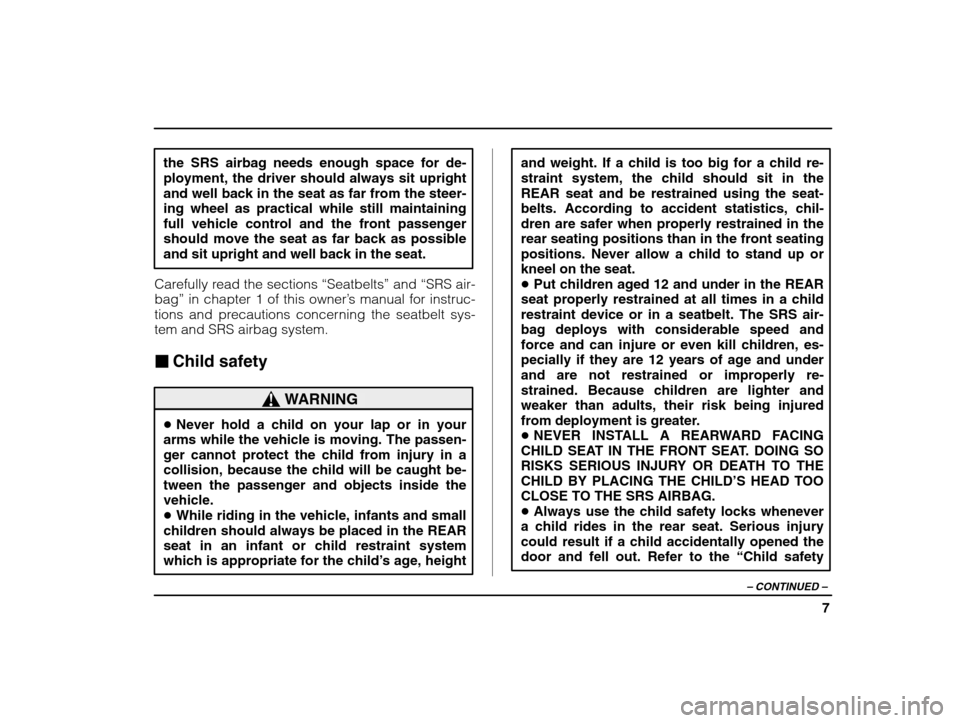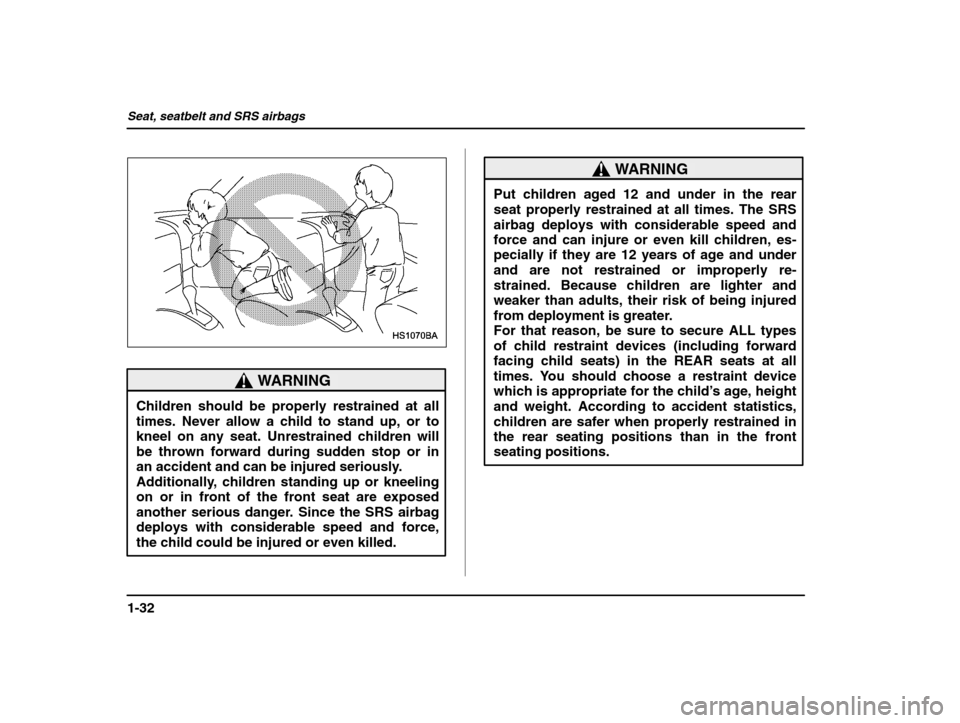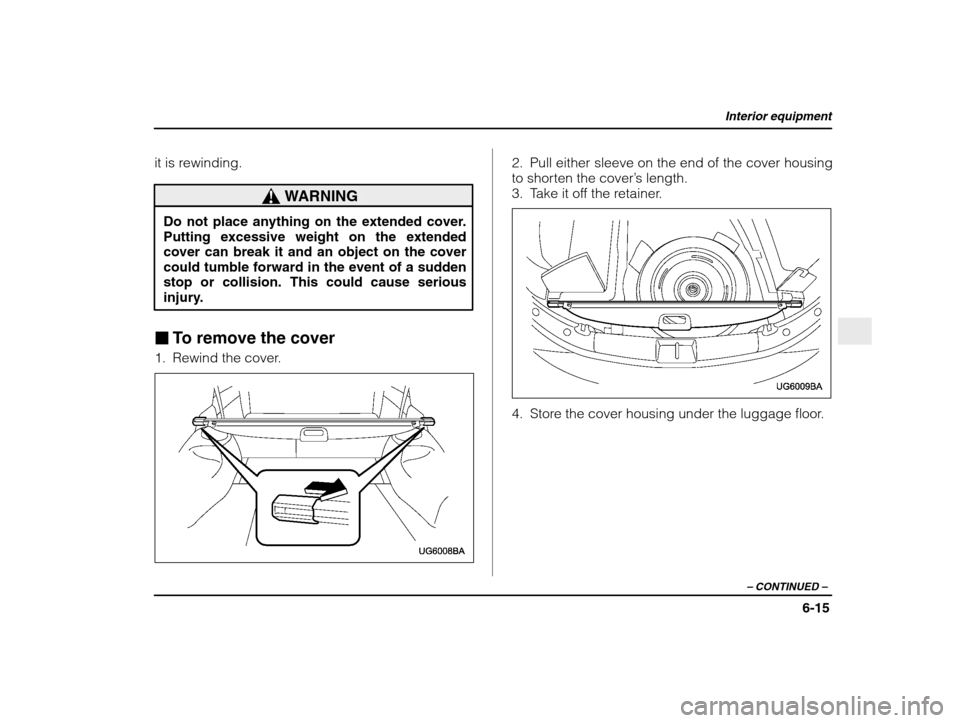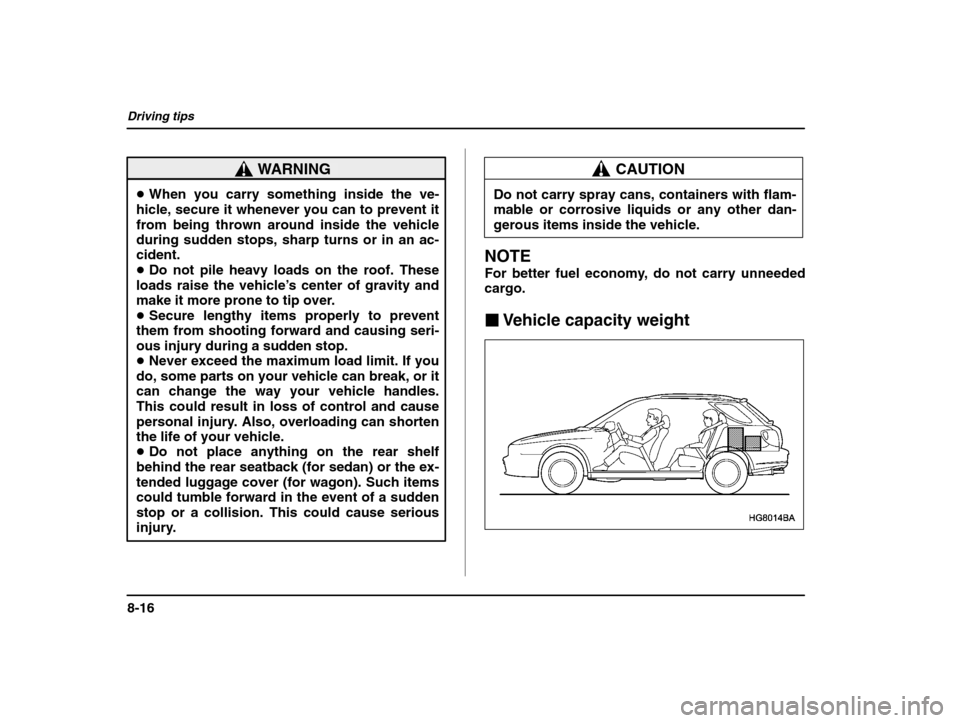2003 SUBARU IMPREZA weight
[x] Cancel search: weightPage 10 of 425

7
– CONTINUED –
the SRS airbag needs enough space for de- ployment, the driver should always sit uprightand well back in the seat as far from the steer-ing wheel as practical while still maintainingfull vehicle control and the front passengershould move the seat as far back as possible and sit upright and well back in the seat.
Carefully read the sections “Seatbelts” and “SRS air-
bag” in chapter 1 of this owner ’s manual for instruc-
tions and precautions concerning the seatbelt sys- tem and SRS airbag system. � Child safety
WARNING
�Never hold a child on your lap or in your
arms while the vehicle is moving. The passen- ger cannot protect the child from injury in a
collision, because the child will be caught be-tween the passenger and objects inside thevehicle.� While riding in the vehicle, infants and small
children should always be placed in the REAR seat in an infant or child restraint system which is appropriate for the child ’s age, height and weight. If a child is too big for a child re-straint system, the child should sit in the
REAR seat and be restrained using the seat-
belts. According to accident statistics, chil-dren are safer when properly restrained in therear seating positions than in the front seating positions. Never allow a child to stand up or
kneel on the seat.�
Put children aged 12 and under in the REAR
seat properly restrained at all times in a childrestraint device or in a seatbelt. The SRS air-bag deploys with considerable speed and force and can injure or even kill children, es-
pecially if they are 12 years of age and underand are not restrained or improperly re-strained. Because children are lighter and
weaker than adults, their risk being injured
from deployment is greater. � NEVER INSTALL A REARWARD FACING
CHILD SEAT IN THE FRONT SEAT. DOING SO
RISKS SERIOUS INJURY OR DEATH TO THE
CHILD BY PLACING THE CHILD ’S HEAD TOO
CLOSE TO THE SRS AIRBAG.� Always use the child safety locks whenever
a child rides in the rear seat. Serious injurycould result if a child accidentally opened thedoor and fell out. Refer to the “Child safety
Page 28 of 425

Seat, seatbelt and SRS airbags
1-3
– CONTINUED –
restraint devices) sit in the REAR seat properly
restrained at all times in a child restraint device
or in a seatbelt, whichever is appropriate for
the child’s age, height and weight. Secure ALL
types of child restraint devices (including for-
ward facing child seat) in the REAR seats at all times.
NEVER INSTALL A REARWARD FACING CHILD
SEAT IN THE FRONT SEAT. DOING SO RISKS
SERIOUS INJURY OR DEATH TO THE CHILD
BY PLACING THE CHILD ’S HEAD TOO CLOSE
TO THE SRS AIRBAG.
According to accident statistics, children are
safer when properly restrained in the rear seat-
ing positions than in the front seating posi-
tions. For instructions and precautions con-
cerning child restraint systems, see the “Child
restraint systems ” section in this chapter. �
Fore and aft adjustment
Pull the lever upward and slide the seat to the de-
sired position. Then release the lever and move the
seat back and forth to make sure that it is securelylocked into place.
Page 38 of 425

Seat, seatbelt and SRS airbags
1-13
– CONTINUED –
pecially if they are 12 years of age and under and are not restrained or improperly re-strained. Because children are lighter and
weaker than adults, their risk of being injured
from deployment is greater. For that reason,we strongly recommend that ALL children (in- cluding those in child seats and those that
have outgrown child restraint devices) sit inthe REAR seat properly restrained at all times
in a child restraint device or in a seatbelt,whichever is appropriate for the child ’s height
and weight. Secure ALL types of child restraint devices
(including forward facing child seats) in the
REAR seats at all times.
NEVER INSTALL A REARWARD FACING
CHILD SEAT IN THE FRONT SEAT. DOING SO
RISKS SERIOUS INJURY OR DEATH TO THE
CHILD BY PLACING THE CHILD ’S HEAD TOO
CLOSE TO THE SRS AIRBAG.
According to accident statistics, children are
safer when properly restrained in the rearseating positions than in the front seating
positions. For instructions and precautions
concerning the child restraint system, see the “ Child restraint systems ” section in this chap-
ter. �
Infants or small children
Use a child restraint system that is suitable for your
vehicle. See information on “Child restraint systems ”
in this chapter.
� Children
If a child is too big for a child restraint system, the
child should sit in the rear seat and be restrained
using the seatbelts. According to accident statistics,
children are safer when properly restrained in the
rear seating positions than in the front seating posi-tions. Never allow a child to stand up or kneel on theseat.
If the shoulder portion of the belt crosses the face or
neck, adjust the shoulder belt anchor height (win- dow-side seating positions only) and then if neces-
sary move the child closer to the belt buckle to help
provide a good shoulder belt fit. Care must be taken
to securely place the lap belt as low as possible onthe hips and not on the child ’s waist. If the shoulder
portion of the belt cannot be properly positioned, a
child restraint system should be used. Never placethe shoulder belt under the child ’s arm or behind the
child’ s back.
Page 57 of 425

Seat, seatbelt and SRS airbags
1-32
WARNING
Children should be properly restrained at all times. Never allow a child to stand up, or tokneel on any seat. Unrestrained children willbe thrown forward during sudden stop or in
an accident and can be injured seriously.
Additionally, children standing up or kneeling on or in front of the front seat are exposed
another serious danger. Since the SRS airbag
deploys with considerable speed and force,the child could be injured or even killed.
WARNING
Put children aged 12 and under in the rear seat properly restrained at all times. The SRSairbag deploys with considerable speed andforce and can injure or even kill children, es-
pecially if they are 12 years of age and under and are not restrained or improperly re-strained. Because children are lighter and
weaker than adults, their risk of being injured
from deployment is greater.
For that reason, be sure to secure ALL types of child restraint devices (including forward
facing child seats) in the REAR seats at all
times. You should choose a restraint devicewhich is appropriate for the child’s age, height
and weight. According to accident statistics,children are safer when properly restrained in the rear seating positions than in the front seating positions.
Page 69 of 425

Seat, seatbelt and SRS airbags
1-44
and those that have outgrown child restraint
devices) sit in the REAR seat properly re-strained at all times in a child restraint deviceor in a seatbelt, whichever is appropriate forthe child’s age, height and weight.
Secure ALL types of child restraint devices
(including forward facing child seats) in the
REAR seats at all times.
According to accident statistics, children are
safer when properly restrained in the rearseating positions than in the front seatingpositions. For instructions and precautions concerning the child restraint system, see the “Child re-
straint systems ” section in this chapter.
� NEVER INSTALL A REARWARD FACING
CHILD SEAT IN THE FRONT SEAT. DOING SO
RISKS SERIOUS INJURY OR DEATH TO THE
CHILD BY PLACING THE CHILD ’S HEAD TOO
CLOSE TO THE SRS AIRBAG. � Never allow a child to stand up, or to kneel
on the front passenger ’s seat, or never hold a
child on your lap or in your arms. The SRS air-bag deploys with considerable force and can injure or even kill the child.CAUTION
� When the SRS airbag deploys, some smoke
will be released. This smoke could cause breathing problems for people with a history of asthma or other breathing trouble. If you oryour passengers have breathing problems af-
ter SRS airbag deploys, get fresh air promptly.� A deploying SRS airbag releases hot gas.
Occupants could get burnt if they come into direct contact with the hot gas.
NOTE When you sell your vehicle, we urge you to ex- plain to the buyer that it is equipped with SRS
airbags by alerting him to the applicable sectionin this owner ’s manual.
Page 218 of 425

Interior equipment
6-15
– CONTINUED –
it is rewinding.
WARNING
Do not place anything on the extended cover. Putting excessive weight on the extended
cover can break it and an object on the covercould tumble forward in the event of a sudden
stop or collision. This could cause serious
injury.
� To remove the cover
1. Rewind the cover.
2. Pull either sleeve on the end of the cover housing
to shorten the cover ’s length.
3. Take it off the retainer.
4. Store the cover housing under the luggage floor.
Page 254 of 425

8
8-1
– CONTINUED –
New vehicle break-in driving –
the first 1,000 miles (1,600 km) 8-2 . . . . . . . . . . . . . . .
Fuel economy hints 8-2 . . . . . . . . . . . . . . . . . . . . . . . . . . . . . . . .
Engine exhaust gas (Carbon monoxide) 8-3 . . . .
Catalytic converter 8-4 . . . . . . . . . . . . . . . . . . . . . . . . . . . . . . . . .
Periodic inspections 8-5 . . . . . . . . . . . . . . . . . . . . . . . . . . . . . . .
Driving in foreign countries 8-6 . . . . . . . . . . . . . . . . . . . . .
Driving tips for AWD vehicles 8-6 . . . . . . . . . . . . . . . . . .
Off road driving 8-8 . . . . . . . . . . . . . . . . . . . . . . . . . . . . . . . . . . . . . .
All AWD models except OUTBACK SPORT 8-8 . . .
OUTBACK SPORT 8-8 . . . . . . . . . . . . . . . . . . . . . . . . . . . . . . . . .
Winter driving 8-10 . . . . . . . . . . . . . . . . . . . . . . . . . . . . . . . . . . . . . . . .
Operation during cold weather 8-10 . . . . . . . . . . . . . . . . .
Driving on snowy and icy roads 8-12 . . . . . . . . . . . . . . . .
Corrosion protection 8-13 . . . . . . . . . . . . . . . . . . . . . . . . . . . . . .
Snow tires 8-13
. . . . . . . . . . . . . . . . . . . . . . . . . . . . . . . . . . . . . . . . . . .
Tire chains 8-14
. . . . . . . . . . . . . . . . . . . . . . . . . . . . . . . . . . . . . . . . . .
Rocking the vehicle 8-15 . . . . . . . . . . . . . . . . . . . . . . . . . . . . . . .
Loading your vehicle 8-15 . . . . . . . . . . . . . . . . . . . . . . . . . . . . . .
Vehicle capacity weight 8-16 . . . . . . . . . . . . . . . . . . . . . . . . . .
GVWR and GAWR (Gross Vehicle Weight
Rating and Gross Axle Weight Rating) 8-17 . . . . . .
Roof rail and crossbar (if equipped) 8-18 . . . . . . . . . . .
Trailer hitch (if equipped) 8-23 . . . . . . . . . . . . . . . . . . . . . . . .
Connecting a trailer 8-24 . . . . . . . . . . . . . . . . . . . . . . . . . . . . . . .
When you do not tow a trailer 8-26 . . . . . . . . . . . . . . . . . . .
Trailer towing 8-27 . . . . . . . . . . . . . . . . . . . . . . . . . . . . . . . . . . . . . . . . . Warranties and maintenance 8-27
. . . . . . . . . . . . . . . . . . . .
Maximum load limits 8-27 . . . . . . . . . . . . . . . . . . . . . . . . . . . . . .
Trailer hitches 8-32 . . . . . . . . . . . . . . . . . . . . . . . . . . . . . . . . . . . . . .
Connecting a trailer 8-33 . . . . . . . . . . . . . . . . . . . . . . . . . . . . . . .
Trailer towing tips 8-35 . . . . . . . . . . . . . . . . . . . . . . . . . . . . . . . . .
Driving tips
Page 269 of 425

Driving tips
8-16
WARNING
�When you carry something inside the ve-
hicle, secure it whenever you can to prevent it from being thrown around inside the vehicleduring sudden stops, sharp turns or in an ac- cident. � Do not pile heavy loads on the roof. These
loads raise the vehicle ’s center of gravity and
make it more prone to tip over.� Secure lengthy items properly to prevent
them from shooting forward and causing seri- ous injury during a sudden stop. � Never exceed the maximum load limit. If you
do, some parts on your vehicle can break, or itcan change the way your vehicle handles.This could result in loss of control and cause
personal injury. Also, overloading can shorten the life of your vehicle. � Do not place anything on the rear shelf
behind the rear seatback (for sedan) or the ex-
tended luggage cover (for wagon). Such itemscould tumble forward in the event of a suddenstop or a collision. This could cause serious
injury.
CAUTION
Do not carry spray cans, containers with flam- mable or corrosive liquids or any other dan- gerous items inside the vehicle.
NOTE
For better fuel economy, do not carry unneeded cargo. � Vehicle capacity weight